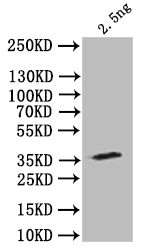To create the stau polyclonal antibody, a recombinant Drosophila melanogaster (Fruit fly) stau protein segment (321-582aa) is used as the immunogen to stimulate an antibody response in a rabbit. CUSABIO collects the rabbit serum and then purifies it using affinity chromatography to obtain the polyclonal antibodies against stau. The proficiency of the stau antibody in detecting the Drosophila melanogaster (Fruit fly) stau protein is confirmed through ELISA and WB assays, ensuring its effectiveness in experimental conditions.
The Staufen (Stau) protein in Drosophila melanogaster serves as a multifunctional regulator of RNA metabolism and cellular processes. Notably, Staufen plays a pivotal role in the localization of specific mRNAs, particularly in neurons, facilitating localized protein synthesis crucial for synaptic plasticity and neuronal development. Additionally, Staufen is involved in post-transcriptional gene regulation, impacting mRNA stability and translation, thus contributing to the overall control of protein levels in the cell. Furthermore, Staufen is implicated in cellular responses to environmental stress, such as heat stress, and has connections to the RNA interference pathway.







